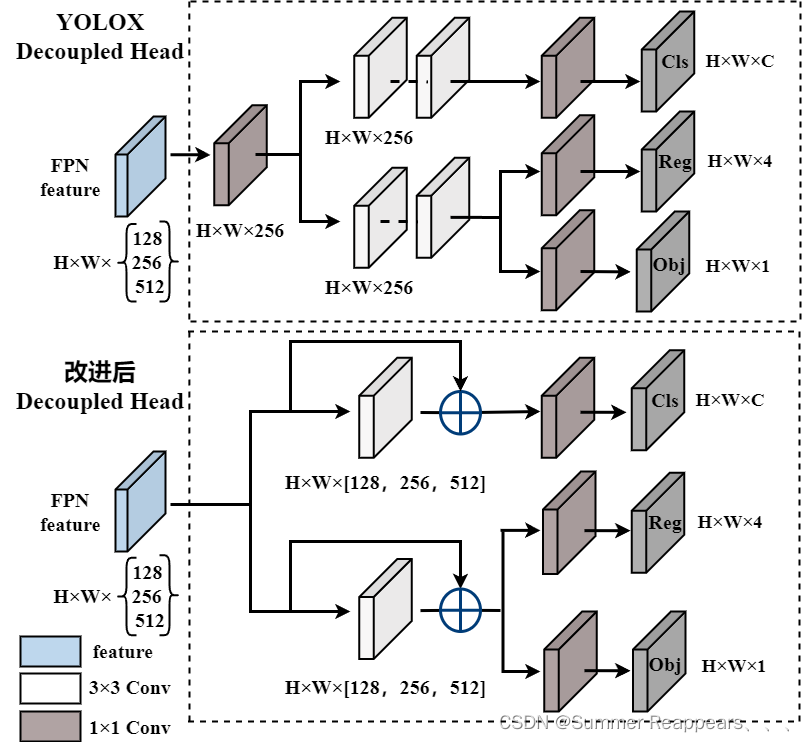在看文献时,发现一篇对YOLOX的解耦头改进然后用在YOLOv5的论文,这里复现了下代码
再次声明下,并不是所有的改进用在你的数据集就会涨点,有时候也会适得其反,这个改进不行,那就换另一个,没必要认准一个死磕
一、改进解耦头结构
为什么这么改,论文里也有提到

二、代码部分
这里你需要去看我上一篇有关YOLOv5替换解耦头的博客,在此基础上进行的改进,代码如下
class DecoupledHead(nn.Module):
######################### 初始模块 ###########################################
# def __init__(self, ch=256, nc=80, anchors=()):
# super().__init__()
# self.nc = nc # number of classes
# self.nl = len(anchors) # number of detection layers
# self.na = len(anchors[0]) // 2 # number of anchors
# self.merge = Conv(ch, 256 , 1, 1)
# self.cls_convs1 = Conv(256 , 256 , 3, 1, 1)
# self.cls_convs2 = Conv(256 , 256 , 3, 1, 1)
# self.reg_convs1 = Conv(256 , 256 , 3, 1, 1)
# self.reg_convs2 = Conv(256 , 256 , 3, 1, 1)
# self.cls_preds = nn.Conv2d(256 , self.nc * self.na, 1)
# self.reg_preds = nn.Conv2d(256 , 4 * self.na, 1)
# self.obj_preds = nn.Conv2d(256 , 1 * self.na, 1)
#
# def forward(self, x):
# x = self.merge(x)
# x1 = self.cls_convs1(x)
# x1 = self.cls_convs2(x1)
# x1 = self.cls_preds(x1)
# x2 = self.reg_convs1(x)
# x2 = self.reg_convs2(x2)
# x21 = self.reg_preds(x2)
# x22 = self.obj_preds(x2)
# out = torch.cat([x21, x22, x1], 1)
# return out
def __init__(self, ch=256, nc=80, anchors=()):
super().__init__()
self.nc = nc # number of classes
self.nl = len(anchors) # number of detection layers
self.na = len(anchors[0]) // 2 # number of anchors
self.cls_convs1 = Conv_shortcut(ch , ch , 3, 1)
self.reg_convs1 = Conv_shortcut(ch , ch , 3, 1)
self.cls_preds = nn.Conv2d(ch , self.nc * self.na, 1) # 一个1x1的卷积,把通道数变成类别数,比如coco 80类(主要对目标框的类别,预测分数)
self.reg_preds = nn.Conv2d(ch , 4 * self.na, 1) # 一个1x1的卷积,把通道数变成4通道,因为位置是xywh
self.obj_preds = nn.Conv2d(ch , 1 * self.na, 1) # 一个1x1的卷积,把通道数变成1通道,通过一个值即可判断有无目标(置信度)
def forward(self, x):
x1 = self.cls_convs1(x)
x1 = self.cls_preds(x1)
x2 = self.reg_convs1(x)
x21 = self.reg_preds(x2)
x22 = self.obj_preds(x2)
out = torch.cat([x21, x22, x1], 1) # 把分类和回归结果按channel维度,即dim=1拼接
return out
class Conv_shortcut(nn.Module):
def __init__(self, c1, c2, k=1, s=1, p=None, g=1, act=True): # ch_in, ch_out, kernel, stride, padding, groups
super().__init__()
self.conv = nn.Conv2d(c1, c2, k, s, autopad(k, p), groups=g, bias=False)
self.bn = nn.BatchNorm2d(c2)
self.act = nn.SiLU() if act is True else (act if isinstance(act, nn.Module) else nn.Identity())
# # self.shortcut = nn.Sequential()
# # if c1 != c2:
# # self.shortcut = nn.Sequential(
# # nn.Conv2d(c1, c2, kernel_size=1, stride=1, bias=False),
# # nn.BatchNorm2d(c2)
# # )
def forward(self, x):
y = self.bn(self.conv(x))
# y = self.shortcut(x)
# x1 += self.shortcut(x)
y = self.act(y)
return x + y
我运行没问题,有报错请在评论区评论(最近并没有研究yolo,报错可能爱莫能助)
